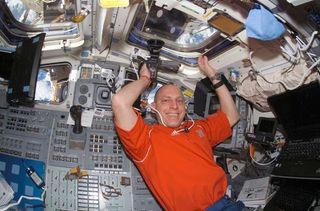U.S. Astronaut Readapts to Life on Earth

A NASA astronautis settling back into life on Earth after a five-month trek to theInternational Space Station (ISS).
U.S. spaceflyerClayton Anderson worked in Earth orbit for about 153 days while serving on twoISS crews during his long-duration spaceflight. He has spent the last few weeksundergoing physical rehabilitation to rebuild muscle mass after months of floatingin microgravity.
"Ifeel really good," Anderson told SPACE.com Thursday. "I'mstarting to run a little bit and my muscles are coming back. I haven't walkedinto a wall in over two weeks, so everything is going well."
Anderson,48, launched toward the ISS on June 8 during NASA's STS-117 shuttle flight andjoined the station's Expedition 15 crew. He stayed aboard the ISS in October tojoin the newly arrived Expedition 16 crew. The spaceflyer returned to Earthaboard NASA's shuttle Discovery on Nov. 7 during the STS-120mission.
Thespaceflight marked the first of Anderson's NASA career, which began almost 25years ago when he signed on at the agency's Johnson Space Center (JSC) inHouston in early 1983. After 15 attempts, he was selected to join NASA'sastronaut corps in 1998.
"I wasin space only because of the people here at JSC who helped to shape me and makewho I am throughout those 25 years," Anderson said. "It's an honorand a privilege to be up there and represent them and the things that they'redoing."
Andersonperformed three spacewalks to support ISS construction and worked alongside NASA'svisiting STS-117, STS-118 and STS-120 shuttle crews during his spaceflight. Thestation received a pair of new solar arrays, a vital connecting module and weatheredcomputer glitches, a ripped solar wing and other hurdles during the threeshuttle missions.
Get the Space.com Newsletter
Breaking space news, the latest updates on rocket launches, skywatching events and more!
"So Ithink they wanted to get me back onto the ground so some of that would stop,and it looks like it may have worked," joked Anderson.
A nativeAshland, Nebraska, Anderson is his home state's first astronaut to fly and wasknown for his sense of humor in orbit. On Halloween, he donned a black cape todress up as a space vampire and held daily trivia contests with Mission Control.
"Ithink that's what people need to see," Anderson said. "They need to seethat we live on the station just like we live on the ground, and I didn't wantto change who I am while up there."
Aside fromreadapting to Earth's gravity and rebuilding lost muscle mass, Anderson saidthere are other challenges to returning to life on his home planet.
"Thehardest part is, I couldn't remember any of my passwords or how to operate myTV or my phone, so my son had to show me all that stuff," Anderson said,adding that he is readjusting to life with his family close by aftermonths communicating solely by video conference and telephone.
He also enjoyed returninghome in time for Thanksgiving to celebrate the U.S. holiday with his wife Susan,son Cole and daughter Sutton Marie.
"I wasso tired of smoked turkey and dressing and a tortilla in space that, to havethe real thing and be there with my family was an incredibly wonderfulday," Anderson said.
- VIDEO: ISS Commander Peggy Whitson Takes Charge
- IMAGES: The STS-120 Shuttle Mission from Orbit to Earth
- VIDEO: Orbital Acrobatics Aboard Space Station
Join our Space Forums to keep talking space on the latest missions, night sky and more! And if you have a news tip, correction or comment, let us know at: community@space.com.

Tariq is the Editor-in-Chief of Space.com and joined the team in 2001, first as an intern and staff writer, and later as an editor. He covers human spaceflight, exploration and space science, as well as skywatching and entertainment. He became Space.com's Managing Editor in 2009 and Editor-in-Chief in 2019. Before joining Space.com, Tariq was a staff reporter for The Los Angeles Times covering education and city beats in La Habra, Fullerton and Huntington Beach. In October 2022, Tariq received the Harry Kolcum Award for excellence in space reporting from the National Space Club Florida Committee. He is also an Eagle Scout (yes, he has the Space Exploration merit badge) and went to Space Camp four times as a kid and a fifth time as an adult. He has journalism degrees from the University of Southern California and New York University. You can find Tariq at Space.com and as the co-host to the This Week In Space podcast with space historian Rod Pyle on the TWiT network. To see his latest project, you can follow Tariq on Twitter @tariqjmalik.
